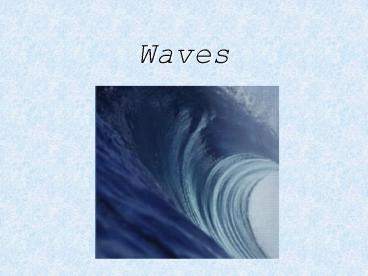Waves - PowerPoint PPT Presentation
1 / 28
Title:
Waves
Description:
Longitudinal Waves vibrate in the direction of motion. Examples: Sound, P-Waves, 'Slinky' Waves. Wave Properties ... a wine glass with sound? Why did the Tacoma ... – PowerPoint PPT presentation
Number of Views:45
Avg rating:3.0/5.0
Title: Waves
1
Waves
2
What is a Wave?
- A wave is an energy vibration that usually takes
place in matter - Key word vibration. Waves repeat
- A single wave is called a pulse
3
Wave Types
- Transverse Waves vibrate at a right angle to
their direction of motion - Examples Light, ocean waves, waves on a rope
4
- Longitudinal Waves vibrate in the direction of
motion - Examples Sound, P-Waves, Slinky Waves
5
Wave Properties
- We use four different characteristics to talk
about waves frequency, wavelength, amplitude,
period, and speed - Wavelength is the distance between identical
parts of a wave (crest?crest, trough?trough) - Amplitude is half the waves total height, or the
distance between the crest and the rest position
6
Wave Time
- A waves period is the time it takes for one
vibration to occur - If you divide wavelength by time, you get a
waves speed (speed distance/time)
7
(No Transcript)
8
Frequency
- A waves frequency tells us how often waves occur
(2 waves a second, 4 waves a second, etc) - The units of frequency are Hertz, or Hz
- 1 Hz 1 wave/second
- Frequency 1/period
9
Source or Medium Dependence?
- Amplitude?
- Source Energy
- Period
- Source
- Speed
- Medium
- Wavelength
- Medium/Source
10
Some Wavelengths
- Microwaves .03 m
- Radio Waves 10 m
- Ocean Waves 200 m
- Tsunami 11,000 m
- 200,000 m
11
Two Views
- Position/Time View
- We focus on how one point on the wave evolves in
time - Snapshot View
- We focus on how the wave evolves in multiple
dimension
12
Time View
13
- Which wave properties can we deduce from this
graph?
14
Snapshot
15
- What can we deduce from this graph?
16
(No Transcript)
17
Interference with Standing Waves
18
(No Transcript)
19
Resonance
- Questions of Interest
- Can you break a wine glass with sound?
- Why did the Tacoma Narrows bridge collapse?
20
Forced Vibrations
- Vibrating an object at a specific frequency
- Think back to the lab from last week (part C)
- Forced vibrations can create either organized or
unorganized patterns - On what does the patterns organization depend?
21
Natural Frequency
- Most objects (media) have so called natural
frequencies - If we vibrate an object at one or more of its
natural frequencies, something interesting occurs
22
Resonance
- When a source vibrates an object at its natural
frequency, we call it resonance - You can create large amplitudes with fairly small
input
23
(No Transcript)
24
Other Examples?
- Swing sets
- Singing in the shower
- Tuning fork
- Standing waves on spring
25
Raising the stakes
- If you continue vibrating something at its
resonance frequency, the amplitude of the
vibration increases
26
Shattering a Wine Glass?
27
(No Transcript)
28
(No Transcript)































